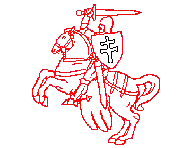April 26, 2015
The day of mourning for the victims of Chernobyl nuclear catastrophe.
May 9, 2015
Victory Day!
See Events section
for more details |
|
Belarus
Belarus,
officially the Republic of Belarus, is a landlocked country in Eastern
Europe, bordered clockwise by Russia to the northeast, Ukraine to the
south, Poland to the west, and Lithuania and Latvia to the northwest.
Its capital is Minsk; other major cities include Brest, Grodno (Hrodna),
Gomel (Homiel), Mogilev (Mahilyow) and Vitebsk (Viciebsk). Forty percent
of its 207,600 square kilometres (80,200 sq mi) is forested, and its strongest
economic sectors are agriculture and manufacturing.
Until the 20th century,
the lands of modern day Belarus belonged to several countries, including
the Principality of Polotsk, the Grand Duchy of Lithuania, the Russian
Empire, and the Polish–Lithuanian Commonwealth. As a result of the Russian
Revolution, Belarus became a founding constituent republic of the Soviet
Union and was renamed as the Belorussian SSR. The final unification of
the modern day
|
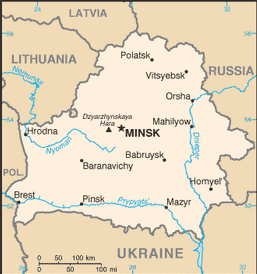 |
Belarusian lands took place
in 1939 when lands that were part of the Second Polish Republic were united
with the Belorussian Soviet Socialist Republic as a result of the Soviet invasion
of Poland. The territory and its nation were devastated in World War II, during
which Belarus lost about a third of its population and more than half of its
economic resources. The republic was redeveloped in the post-war years. In 1945
the Belorussian SSR became a founding member of the United Nations, along with
the Soviet Union and the Ukrainian SSR.
The parliament of the republic
declared the sovereignty of Belarus on 27 July 1990, and during the collapse
of the Soviet Union, Belarus declared independence on 25 August 1991. Alexander
Lukashenko has been the country's president since 1994. Under his lead and despite
objections from Western governments, Soviet-era policies, such as state ownership
of the economy have been continued. According to some organizations and countries,
elections have been unfair, and political opponents have been violently suppressed.
Since 2000, Belarus and Russia signed a treaty for greater cooperation, with
some hints of forming a Union State. Belarus also has the highest Human Development
Index among members of the Commonwealth of Independent States.
Most of Belarus's population
of 9.49 million reside in the urban areas surrounding Minsk and other oblast
(regional) capitals. More than 80% of the population are native Belarusians,
with sizable minorities of Russians, Poles and Ukrainians. Since a referendum
in 1995, the country has had two official languages: Belarusian and Russian.
The Constitution of Belarus does not declare an official religion, although
the primary religion in the country is Russian Orthodox Christianity. The second
most popular, Roman Catholicism, has a much smaller following by comparison,
but both Orthodox and Catholic Christmas and Easter are officially celebrated
as national holidays.
History
The name "Belarus"
derives from the term "White Ruthenia" (White Rus). There are several
claims to where the origin of the name "White Rus" came from. An ethno-religious
theory suggests that the name used to describe the part of old Ruthenian lands
within the Grand Duchy of Lithuania that was mostly populated by the early Christianized
Slavs, as opposed to Black Ruthenia, which to a greater extent was inhabited
by predominantly pagan Balts. Another possible origin for the name is for the
white clothing that was worn by the local Slavic population. Yet another theory
suggests that the old Ruthenian lands (Polatsk, Vitsiebsk and Mahilyow) which
were not conquered by the Tatars were referred to as "white". Other
sources claim that before 1267, the land not conquered by the Mongols was considered
"White Rus". The most traditionalist view is the impressionist tendency
in Slavonic cultures to refer to points of the compass by colour, specifically
"black" being "south" and "white" indicating "north",
insofar as the "White Sea" is to the north and the "Black Sea"
is to the south or as Beograd (white capital) is the Serb deference that it
is to the north of their true historic capital, Pristina. Ruthenia was originally
the name of the mid Dniepr region, the cradle of Kievan Rus (modern-day Ukraine).Hence
the land to its immediate north would be "White Ruthenia" (Belarus).
As the names "Ruthenia"
and "Rus" have very often been confused with their modern derivative
"Russia", White Ruthenia has often been referred to as "White
Russia". This misinterpretation has been supported by the Moscovite regents
after the fall of Kievan Rus. The Moskovite dukes, starting with Ivan IV, considered
themselves to be the rightful successors of the Ruthenian grand duke dynasty,
and their use of the name "Russia" as referring to all former Ruthenian
(east slavic) lands became a political weapon and a casus belli for claiming
the west Ruthenian territories from Lithuania and Poland. The name first appeared
in German and Latin medieval literature. In chronicles written by Jan of Czarnków,
he spoke of the Lithuanian grand duke Jogaila and his mother being imprisoned
in 1381 at "Albae Russiae, Poloczk dicto". The Latin term "Alba
Russia" was again used by Pope Pius VI when establishing a Jesuit Society
in 1783. His official Papal bull exclaimed "Approbo Societatem Jesu in
Alba Russia degentem, approbo, approbo." Historically, the country was
referred to in English as "White Ruthenia". The first known use of
"White Russia" to refer to Belarus was in the late-16th century by
Englishman Sir Jerome Horsey, who was known for his close contacts with the
Russian Royal Court. During the 17th century, Russian tsars used "White
Rus"" when describing the lands captured from the Grand Duchy of Lithuania.
Belarus was formally named
"Belorussia" (Russian: Белоруссия; the latter part similar, but spelled
and stressed differently from Россия, "Russia") in the days of the
Russian Empire, and the Russian tsar was usually styled "Tsar of All the
Russias", as "Russia" or the "Russian Empire" was formed
by all the Russias — the Great, Little, and White. At the time, "Byelorussia"
was the only Russian language name of the country; under the Russian Empire,
Belarus was generally seen as a part of the Russian nation and the Belarusian
language was viewed as a dialect of Russian. After the Bolshevik Revolution
in 1917, the term White Russia caused some confusion because it was also the
name of the military force that opposed the "red" Bolsheviks. During
the period of the Belorussian SSR, the term "Byelorussia" was embraced
as part of a national consciousness. In the Polish-held Western Belarus, "Byelorussia"
became commonly used in the regions of Białystok and Grodno during the interwar
period.
The term "Belorussia"
(its names in other languages such as English being based on the Russian form)
was only used officially until 1991, when the Supreme Soviet of the Byelorussian
Soviet Socialist Republic decreed by law that the new independent republic should
be called "Belarus" (Беларусь) in Russian and in all other language
transcriptions of its name. The change was made to reflect adequately the Belarusian
language form of the name. The use of Byelorussian SSR and any abbreviations
of that name was allowed from 1991 until 1993. Conservative forces in the newly
independent Belarus did not support the name change and opposed its inclusion
in the 1991 draft of the Constitution of Belarus.
Accordingly, the name "Belorussia"
was replaced by "Belarus" in English, and, to some extent, in Russian
(although the traditional name still persists in that language as well); likewise,
the adjective "Belorussian" or "Byelorussian" was replaced
by "Belarusian" in English (though Russian has not developed a new
adjective). "Belarusian" is closer to the original Russian term of
"bielaruski." Belarusian intelligentsia in the Stalin era attempted
to change the name from "Belorussia" to a form of "Krivia"
because of the supposed connection with Russia. Some nationalists also object
to the name for the same reason. However, several popular newspapers published
locally still retain the old name of the country in Russian in their names,
for example Komsomolskaya Pravda v Byelorussii, which is the localized publication
of a popular Russian tabloid. Also, those who wish for Belarus to be reunited
with Russia continue to use "Belorussia". Officially, the full name
of the country is "Republic of Belarus" (Рэспубліка Беларусь, Республика
Беларусь, Respublika Belarus")
Ancient History
Both Homo erectus and Neanderthal
remains have been found in the region. Later Neolithic modern man that moved
into the area established from 5000-2000 BCE Bandkerimik cultures, which predominated.
Cimmerians and other pastoralists roamed through the area by 1000 BCE. By 500
BCE, Slavs had taken up residence there, with Scythian pressure on the outskirts
of their territories. Various Asiatic "barbarian" invasions passed
around the region, including Huns and Avars c. 400-600 CE, but did not dislodge
the Slavic presence.
Middle Ages and
Modern Period
| The region
that is now Belarus was first settled by Slavic tribes in the 6th century.
They gradually came into contact with the Varangians, bands of Scandinavian
warriors and traders. Though defeated and briefly exiled by the local population,
the Varangians were later asked to return and helped to form a polity—commonly
referred to as the Kievan Rus'—in exchange for tribute. The Kievan Rus'
state began in about 862 around the city of Kiev or alternatively around
the present-day city of Novgorod.
Upon the death of Kievan Rus' ruler, Yaroslav I the Wise,
the state split into independent principalities.These Ruthenian principalities
were badly affected by a Mongol invasion in the 13th century, and many
were later incorporated into the Grand Duchy of Lithuania.Of the principalities
held by the Duchy, nine were settled by ancestors of the Belarusian people.During
this time the Duchy was involved in several military campaigns, including
fighting on the side of Poland against the Teutonic Knights at the Battle
of Grunwald in 1410; the joint victory allowed the Duchy to control the
northwestern border lands of Eastern Europe.
|
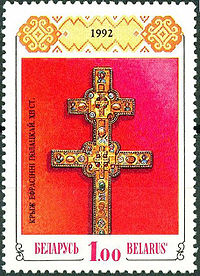 |
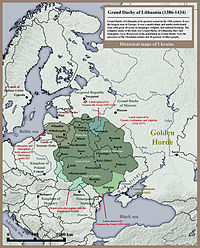
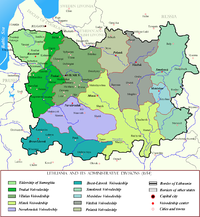
|
On 2 February
1386, the Grand Duchy of Lithuania and the Kingdom of Poland were joined
in a personal union through a marriage of their rulers. This union set in
motion the developments that eventually resulted in the formation of the
Polish–Lithuanian Commonwealth, created in 1569. The Russians, led by Ivan
III of Moscow, began military conquests in 1486 in an attempt to reunite
the Kievan Rus' lands, specifically the territories of modern day Belarus
and Ukraine. |
The
union between Poland and Lithuania ended in 1795 with the partitioning
of Poland by Imperial Russia, Prussia, and Austria. During this time the
territories of modern day Belarus were acquired by the Russian Empire,
under the reign of Catherine II and held until their occupation by German
Empire during World War I.
20 Century
During the negotiations
of the Treaty of Brest-Litovsk, Belarus first declared independence on
25 March 1918, forming the Belarusian People's Republic. The Belarusian
People's Republic was created while under German occupation and it was
one of the first attempts to "Westernize" Belarus. Socialist
Soviet Republic of Byelorussia was proclaimed. Immediately after the formation
of the BPR Polish–Soviet War was started, and Belarus was torn between
resurgent Poland and Soviet Russia, part of Belarus under Russian rule
became the Belorussian Soviet Socialist Republic in 1919. Soon that part
was merged into the Lithuanian–Belorussian Soviet Socialist Republic.
Belarusian lands were then partitioned between Poland and the Soviet Union
after the Polish–Soviet War ended in 1921, and the Belorussian SSR became
a founding member of the Union of Soviet Socialist Republics in 1922.
At the same time Western Belarus remained part of Poland.
A set of agricultural
reforms, culminating in the Belarusian phase of Soviet collectivization,
began in the 1920s. A process of rapid industrialization was undertaken
during the 1930s, following the model of Soviet five-year plans. |
| In 1939,
Nazi Germany and the Soviet Union invaded and occupied Poland, marking the
beginning of World War II. Much of northeastern Poland, which had been part
of the country since the Peace of Riga two decades earlier, was annexed
to the Belorussian Soviet Socialist Republic, and now constitutes West Belarus.
The Soviet-controlled Belarusian People Council officially took control
of the territories, which had a predominantly ethnic Belarusian population,
on October 28, 1939, in Białystok.
Nazi Germany invaded the Soviet Union in 1941 – the Brest
Fortress, which hadbeen
annexed in 1939, received one of the fiercest of the war's opening blows,
with its notable defense in 1941 coming to be remembered as an act of
heroism in countering the German aggression. Statistically, BSSR was the
hardest hit Soviet republic in the war and remained in Nazi hands until
1944.During that time, Germany destroyed 209 out of 290 cities in the
republic, 85% of the republic's industry, and more than one million buildings.
|

 |
| Casualties
were estimated to be between two and three million (about a quarter to one-third
of the total population), while the Jewish population of Belarus was devastated
during the Holocaust and never recovered. The population of Belarus did
not regain its pre-war level until 1971.
After the war ended, Belarus was officially among the
51 founding countries of the United Nations Charter in 1945; along with
Ukraine it was given an additional vote at the UN alongside that of the
Soviet Union. Intense post-war reconstruction was initiated promptly.
During this time, the Belorussian SSR became a major center of manufacturing
in the western region of the USSR, increasing jobs and bringing an influx
of ethnic Russians into the republic. The borders of Belorussian SSR and
Poland were redrawn to a point known as the Curzon Line.
|
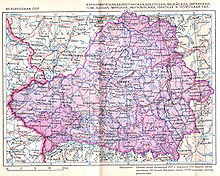 |
Joseph
Stalin implemented a policy of Sovietization to isolate the Belorussian
SSR from Western influences. This policy involved sending Russians from
various parts of the Soviet Union and placing them in key positions in the
Belorussian SSR government. The official use of the Belarusian language
and other cultural aspects were limited by Moscow. After Stalin died in
1953, successor Nikita Khrushchev continued this program, stating, "The
sooner we all start speaking Russian, the faster we shall build communism."
The Belorussian SSR was significantly exposed to nuclear
fallout from the explosion at the Chernobyl power plant in neighboring
Ukrainian SSR in 1986.
|
| In
June 1988 at the rural site of Kurapaty near Minsk, archaeologist Zyanon
Paznyak, the leader of Christian Conservative Party of the BPF, discovered
mass graves of victims executed in 1937–1941. Some nationalists contend
that this discovery is proof that the Soviet government was trying to erase
the Belarusian people, causing Belarusian nationalists to seek independence.Two
years later, in March 1990, elections for seats in the Supreme Soviet of
the Belorussian SSR took place. Though the pro-independence Belarusian Popular
Front took only 10% of the seats, the populace was content with the selection
of the delegates. Belarus declared itself sovereign on 27 July 1990, by
issuing the Declaration of State Sovereignty of the Belarusian Soviet Socialist
Republic. With the support of the Communist Party, the country's name was
changed to the Republic of Belarus on 25 August 1991. Stanislav Shushkevich,
the Chairman of the Supreme Soviet of Belarus, met with Boris Yeltsin of
Russia and Leonid Kravchuk of Ukraine on 8 December 1991, in Belavezhskaya
Pushcha to formally declare the dissolution of the Soviet Union and the
formation of the Commonwealth of Independent States.
A national constitution was adopted in March 1994, in
which the functions of prime minister were given to the president. Two-round
elections for the presidency (24 June 1994 and 10 July 1994) resulted
in the politically unknown Alexander Lukashenko winning more than 45%
of the vote in the first round and 80% in the second round, beating Vyacheslav
Kebich who got 14%. Lukashenko was reelected in 2001, in 2006 and in 2010.
SOURCES: Wikipedia, CIA Factbook
|
To be continued...
|

